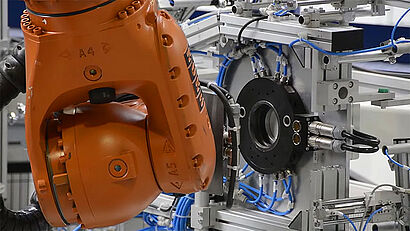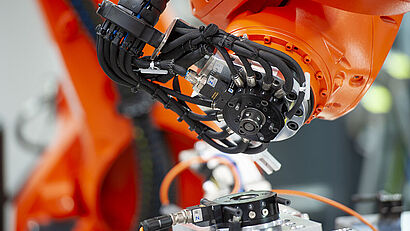The role of tool changers in robotics
The path to full automation
In the world of robotics and automation, tool changers play a crucial role in ensuring smooth processes and maximum efficiency. With a careful selection of tool changers, assembly systems and other robot-based automation solutions can be taken to a new level of performance. The Zimmer Group offers a diverse portfolio of tool changers and supports its customers in selecting the right model for their specific application.
The importance of tool changers in robotics
The use of tool changers enables continuous production without the need for time-consuming interruptions for tool changes. The ability to perform several work steps – such as processing, assembling or transporting workpieces – with just one robot makes tool changers an indispensable part of modern systems.
The integration of tool changers into automated systems offers numerous advantages. Increased productivity and minimized setup and downtime are the two most obvious benefits. The fast tool change allows industrial robots to work continuously and thus fully utilize their capacity. Practical examples show how tool changers are successfully used in various industries. Different types of tool changers enable flexible adaptation to the respective requirements.
The Zimmer Group offers high-quality tool changers and matching accessories such as energy elements, storage stations and much more. “The investment in tool changers is manageable and pays off in the long term, because they can significantly reduce production costs and significantly improve product quality,” says Tobias Hikade, product manager at the Zimmer Group. The automation specialist sees tool changers as an indispensable key element on the road to full automation in industry.
Manual or automatic changing
As an experienced automation partner and handling expert, the Zimmer Group has a comprehensive portfolio of tool changers to offer its customers the right component for every industry and every application. Whether it's for welding, laboratory tasks in a clean room or complex assemblies within a complete system. But how do you find the right tool changer?
Tobias Hikade has the answer: “The choice of the right tool changer depends heavily on the system and the respective application. In the lower and medium load range, for example, our manual tool changers in the HWR and HWR2000 series enable tool changes in seconds,” he explains. “Integrated air transfer units ensure the reliable supply of pneumatic and vacuum actuators. These can be optionally supplemented with a range of energy elements to realize further media such as hydraulics, fluidics, electric currents, signals and field buses.”
The FWR series allows both manual and automatic changing of small and medium loads. Depending on the application, the customer can either carry out the tool change fully automatically without external control or manually by hand. The process in the storage station is purely mechanical, so that no additional energy supply is necessary. In addition to the four pneumatic feedthroughs that are already integrated, corresponding energy elements are also available here for different media transfers.
Securely held, even in the event of a pressure drop
The WWR and WWR1000 series offer maximum flexibility and holding force. With a possible load capacity of up to one ton, the WWR1000 is a real heavyweight. This makes a secure hold all the more important to ensure that neither people nor machines are put at risk. “Safe operation is the top priority for all our tool changers. For example, the combination of spring storage and high transmission ratio ensures a safe machine,” says Tobias Hikade. “The workpiece and tool are held securely even in the event of a pressure drop, for example due to an emergency stop or power failure.”
The extremely flat design of the WWR and WWR1000 series minimizes the moment load for the robot. It also enables the use of more cost-effective and smaller sizes. “And here too, our wide range of media transfer systems means that our customers are not restricted in their applications,” says Tobias Hikade.
As an automation expert with over 40 years of experience, the Zimmer Group is close to its customers and knows that different industries require specific solutions. The cross-technology know-how and the high level of vertical integration enable the company to respond quickly and purposefully to special requirements. The Zimmer Group is always at the cutting edge of technology and is able to make individual adjustments to its standard portfolio based on industry- or customer-specific challenges.
Conclusion: an indispensable role on the road to automation
Tool changers play a central role on the road to full automation, as they significantly increase efficiency and flexibility in production. The extensive program of the Zimmer Group offers customized solutions for a wide range of applications and industries and enables smooth integration into existing systems. The various series cover a wide range of requirements from manual to fully automatic changing processes. Innovative safety functions ensure reliability and durability, which ultimately reflects in the efficiency and cost-effectiveness of the processes. Overall, tool changers are not only an important component of modern automated systems, but also a decisive factor for the future of industrial production.



